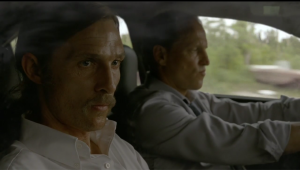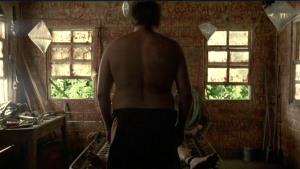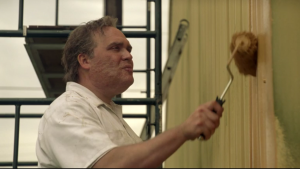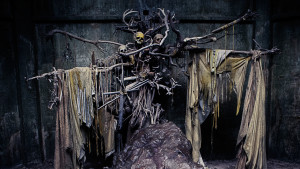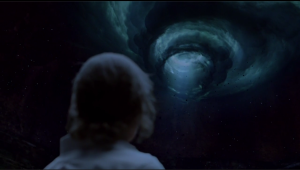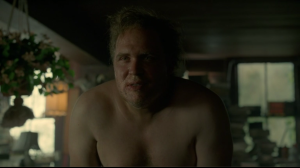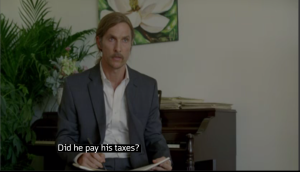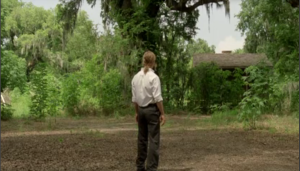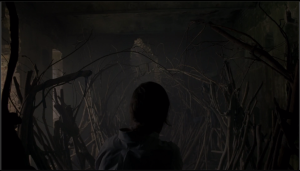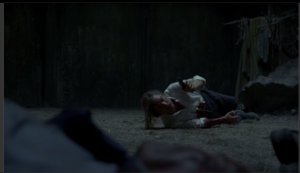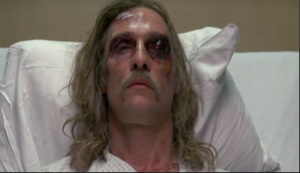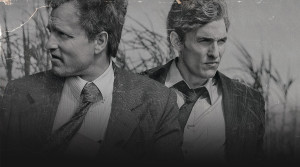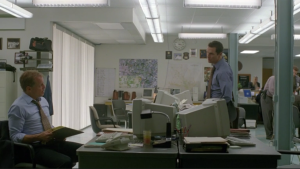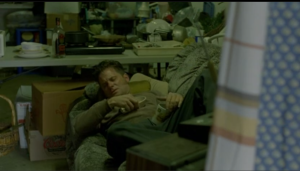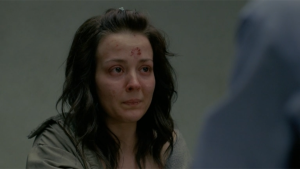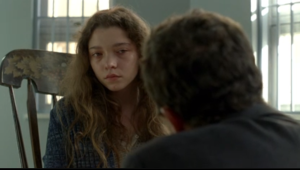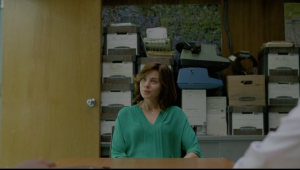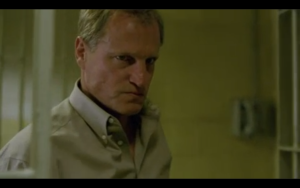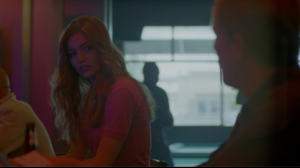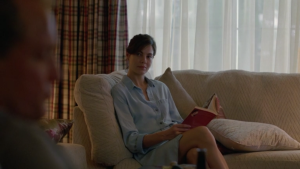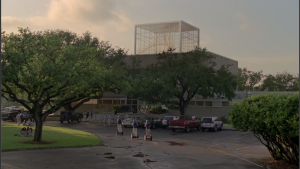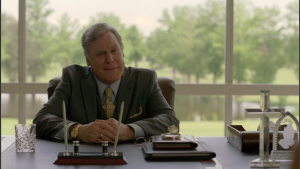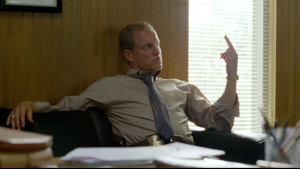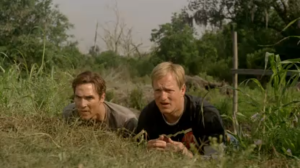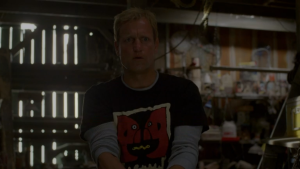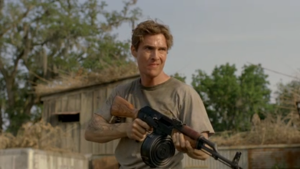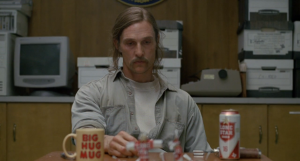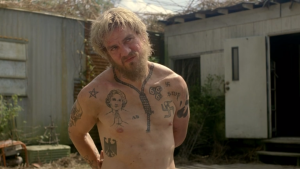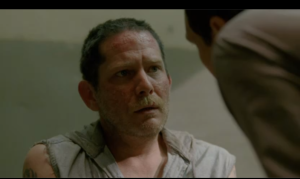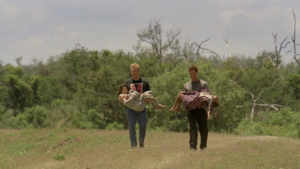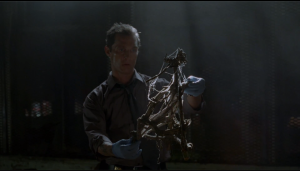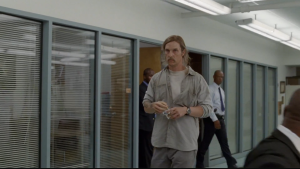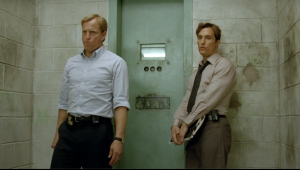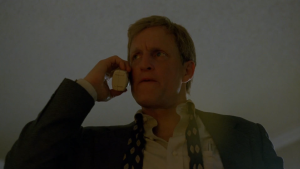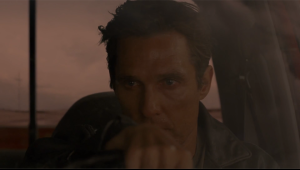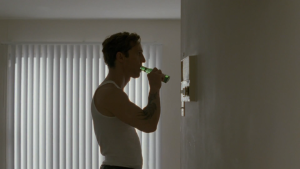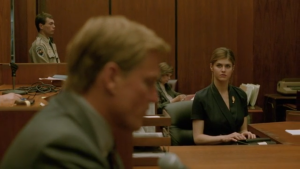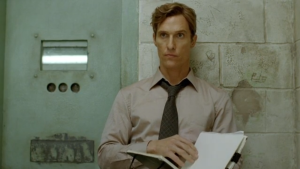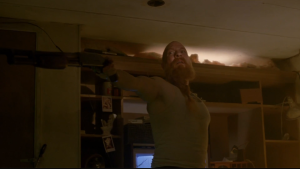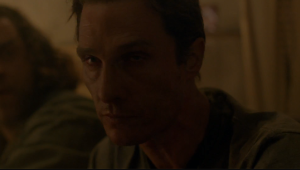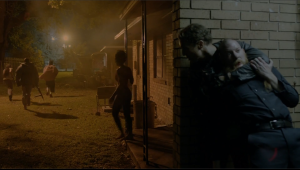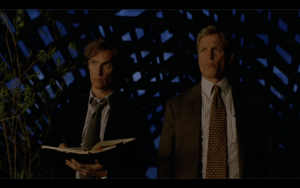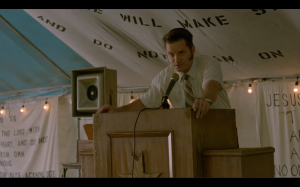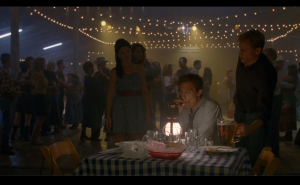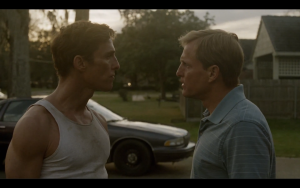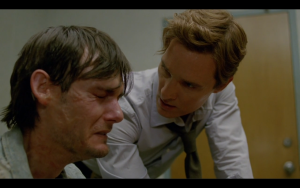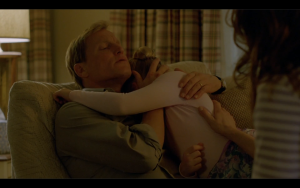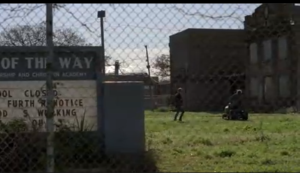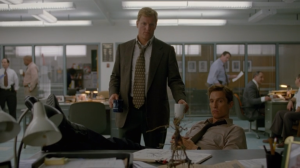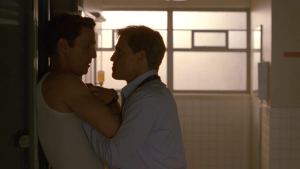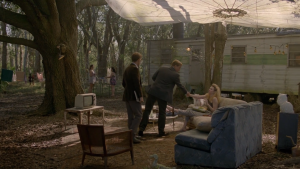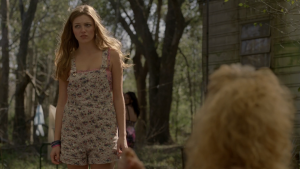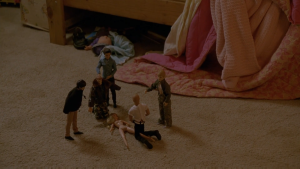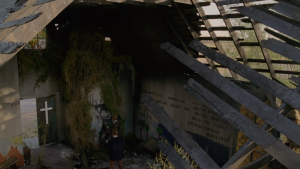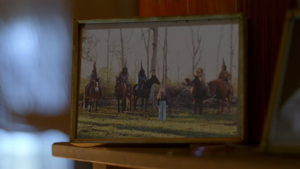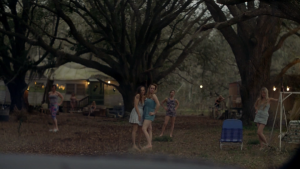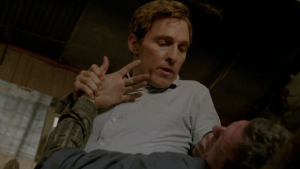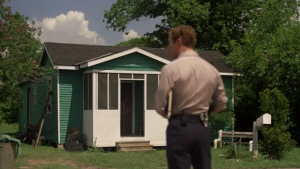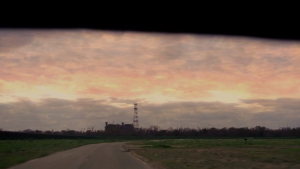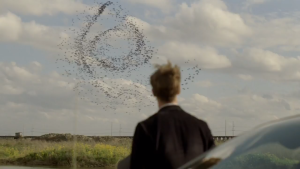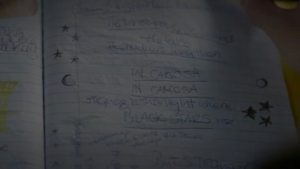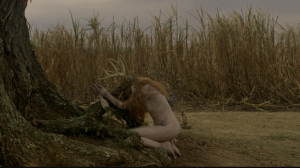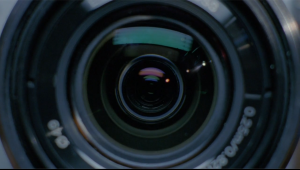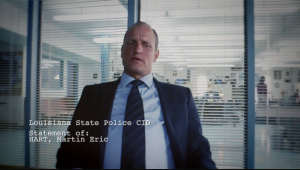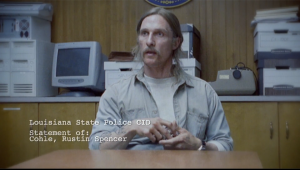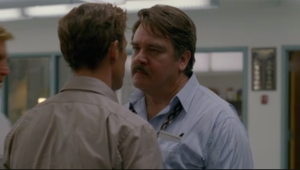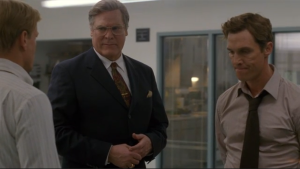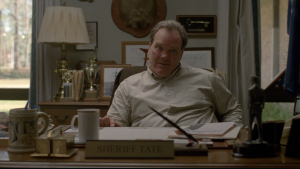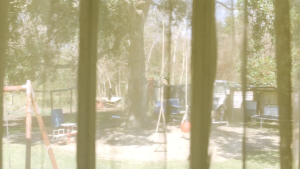“Form and Void”
Calling to mind the very first shot of episode one, “Form and Void”—True Detective’s series finale—opens in similar fashion: with the killer. This time, however, his identity is now fully revealed to be that of Errol Childress—the man with the scars identified at the conclusion of Episode Seven. Within the shed of their abandoned Childress property, Errol is in the midst of horribly torturing a man lying bloody in a room surrounded by bloody, scrawled writing. That man is revealed to be his father, when Errol remarks “Bye, daddy” before stepping out to join his sister in the big house.
Within the decrepit mansion deep in the Bayou backwoods, Errol and this possibly mentally-retarded sister are living in absolute squalor: childish toys are strewn about, dishes are stacked like skyscrapers, and old VHS tapes are piled throughout the space. As an old Cary Grant movie plays upon the TV, Errol begins imitating the voice—almost as though practicing. He later remarks to his sister, “it’s been weeks since I left my mark”. As the two begin to fondle each other, the camera retreats far out the deep bayou wilderness and arrives…
Back with Marty, Rust, and Geraci on the boat. The two former detectives force Geraci to watch the Marie Fontenot tape at gunpoint, then interrogate him for further answers. Geraci, however, can only honestly say that the Childress report was “filed in error” and that he was following a “chain of command”. When leaving Geraci, Cohle warns him about any harm coming their way with the fact that their story is ready to be shipped to all the major newspapers, along with warning sniper-gunfire from the bar owner.
At a nearby school, Errol is shown painting a schoolyard wall (yellow), while eyeing the children during recess. Meanwhile, Marty and Cohle return to their work at the former’s office to look at their old clues with fresh eyes, “like we’re totally green” as per Cohle. This prompts Marty to stare upon the former drawing of the “green-eared spaghetti-monster”, where he questions the detail of the green ears. This incites his investigation into pictures of a green house, where he notices an undeniably new set of fresh green paint, and puts forth his theory that the “spaghetti-monster” may have been the one responsible for painting the house.
In the car on the way over to the residence, the two discuss: their former fight, Marty cheating and Rust’s tryst with Maggie, and more philosophical ideas of values and identity. When arriving at the home with a now faded-green exterior, they are then able to track down the former owner, which then leads them to finding the business—Childress & Sons—by tracking down tax records.
Knowing that they may be facing death, the two instruct the former sniper-wielding bar owner with sending the story and necessary evidence to the papers and authorities. Afterward, Marty secretly meets with Papania. The detective formerly interviewing Marty and suspicious of Rust can tell that the two have been up to something, and though reticent to be involved in their pursuit, agrees that he will take the call.
The two then begin their drive out to the Childress residence, where Marty asks Rust about his visions, to which Rust explains: “What I have in my head, it’s not something that gets better”. Nearing the isolated home, Rust’s synesthesia reminds him of the aluminum taste experienced in Episode One, and upon finding the Childress residence—Rust immediately knows that this is the place. He tells Marty to call Papania, and due to poor cell reception, the former is forced to invade the house. Though the sister plays coy, Marty charges his way inside; wherein, he finds the house to be in an even worse state of squalor than previously thought: mutilated dolls and toys litter the upstairs, while dirt and filth seems to cover everything else.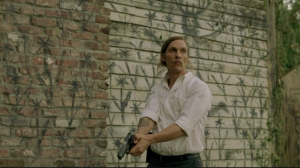
Rust, however, chases after Errol. He follows him into the numerous tunnels found in the back of the property, where he must wend his way around enormous versions of the twig-figure totems found earlier. Errol taunts Cohle throughout the ordeal, leading him onwards, calling him the “little priest”, and even referencing DeWall and Reggie.
Finally, Rust finds the ceremonial chamber at the heart of Carcosa, where a bizarre looking collection of skeletons draped in yellow sit at a throne in center—the Yellow King. Rust’s gaze ascends toward the oval opening above, where he experiences a “vision” of the void—a dark blue, nebulous vortex—until he is stabbed by Errol. He lifts Rust above him, and the latter is able to head-butt his way into temporary safety, though writhes in the ground in bloodied pain. Marty arrives just in time, only to also be attacked by Errol. Just as he prepares to slam down on Marty’s head, Rust fires into Errol’s skull—blowing off his head and finally killing the killer of Dora Lange.
Papania, Gilbough, and a team of responders finally arrive—firing a flare that Marty manages to see—and screams for rescue. Cutting to the hospital afterward, Marty is found slowly recovering. Papania and Gilbough report further details of the Childress clan, though Marty waves them away from informing him of more gruesome horrors. Moments after, Maggie and his children arrive to comfort him. As Audrey, Macie, and Maggie ask how he’s doing, Marty feigns his usual level of masculinity and invincibility, only to slow break down in true tears of devastation.
As news clips give further report toward the uncovering of the Childress clan, Rust is found alive—but badly wounded. Soon after, Marty arrives to comfort him, but Rust finds himself almost incapable of believing in his recovery, reiterating “I shouldn’t be here” and his devastation that they weren’t able to catch “all of them”. To which Marty counters, “We ain’t gonna get ‘em all, but we got ours”.
Outside the hospital, Marty hands Rust a pack of smokes as a gift, then wheels him a bit farther out in the parking lot so that he may be allowed to smoke them. While there, Rust finally breaks down: retelling Marty his experience in the void of darkness, of finding his daughter, his father, and experiencing nothing but love…until he woke up. Possibly trying to cheer him up, Marty points to the stars above him—reminding Rust of his youth in Alaska, wherein Marty points out that the darkness covers a lot more territory than the light. While Marty tries to sneak Rust out of the hospital, he counters Marty’s observation about the stars, telling him: “Once there was only dark. If you ask me, the light’s winning”.
————————————————————————————————————————————
REVIEW
With the setting now completely within the present, and the interviews similarly finished, the finale begins in very atypical fashion for the series by presenting an extended scene not from the point-of-view of either of our two detectives. Even more intriguing, it’s from the perspective of the one character of whom the two have been chasing over the previous seven hours—Errol Childress, the Man with the Scars, sporting a sign of the Yellow King symbol just below his neck (like with Dora Lange). His farewell to his father, whose mouth has been sewn shut and torso horribly mutilated, announces with both style and horror that this long, drawn-out confrontation is finally coming to an end.
As Errol moves into the abandoned manor shared with his slow sister, further evidence of the squalor inhabiting the lives of the Childress Clan is shown. Peeling wallpaper and mildewed portraits of their mother decorate the walls, while an enormous collection of child-like objects litter the floor. Most importantly, there are numerous VHS tapes of old movies that seem to be on a loop within the home. Though this could only be gleaned from interviews with Pizzolatto, the creator explains that Errol used these videos to learn to talk, due to the deformities of his scarred mouth. Moreover, the familial bond between these two—as further demonstrated by their surroundings—gives off the impression that these two are and live like overgrown children. In the way they interact, by their messy home, and fostered by their isolation from society, these two Childress children have matured into adults that retain childlike sensibilities both psychologically and in their relationship to the world.
Nonetheless, Errol’s remark that it’s been “weeks since I left my mark” along with his sudden articulation that: “I have very important work to do. My ascension removes me from the disc in the loop, I’m near final stage…some mornings, I can see the infernal plane” allows for some deeper insight into this killer’s modus operandi. As will be further evidenced near the climax, Errol appears to be baiting the authorities for a confrontation—one who believes that his death (and those of his “acolytes”) will allow for his transcendence into a higher state of being—and a sense that this final confrontation will be happening sooner rather than later.
Meanwhile, the two detectives remain where they left off with Geraci on the boat at the end of Episode Seven. Though this scheme of interrogating him ultimately proves somewhat pointless, as he can only confirm what they already know (that Sheriff Ted Childress is responsible for the Fontenot report error), it does offer a nice sense of conclusion to Rust’s rivalry with his former coworker. Both in showing him the true horror of his actions when forcing him to watch the Fontenot tape, and when threatening him with the sniper rifle of the bar owner (and the destruction of his new car).
Back at the offices, Rust’s phrasing of looking over old evidence files like “we’re totally green” reminds Marty of their strongest piece of evidence yet—the image of the Spaghetti Monster with his green-tipped ears. In a moment of Sherlock-ian inspiration, Marty reconnects the green-tipped ears with the green painted-house—finally earning the highest possible compliment from Rust when he also realizes the connection and utters a “fuck you” to Marty.
On their way over to the green house, Marty attempts to bring closure to his feelings toward Rust, Maggie, and the fight. Though Rust replies with a typically complex philosophical response that leaves Marty befuddled—and elicits one of Marty’s most hilarious malapropisms with “what’s scented meat”—his argument that “everybody’s got a choice” argument actually represents a vastly different moral philosophy than that of Rust in his interview with the detectives, who argued more in line with the Nietzchian ideas of the eternal return (time is a flat circle), which would argue that people are not in control of their choices. Though he is talking more in terms of the formation of our identities in this context, it does raise questions as to his which he actually believes, though perhaps in both talking to Marty and the interrogating detectives, he does not feel the need to give an honest response either way. And instead, will tell them what they need to hear. Nonetheless, a bit later, their tracking down Childress & Sons due to Rust’s asking the former resident Ms Hill, about her husband, the “did he pay his taxes” question—with his ledger in hand—also serves as a nice remembrance to his original “tax man” nickname mentioned (and somewhat forgotten) throughout the rest of the series.
Preparing to finally confront Childress, the two make their preparations in case of death. Rust once again employs the help of the sniper-wielding bar owner to send out their story to various outlets (One to FED, CID, the papers…), while Marty meets with Papania alone to ensure that he will take the call if they need it. Two short scenes that set-up payoffs for after the climax, while also helping to further escalate the tension before the ultimate confrontation.
On the car ride over, Rust’s comments nearing the Childress residence that his synesthesia is picking up elements of “aluminum…ash…I tasted it before” recall his earlier statements in Episode One, where he also experiences similar sensations following their stint in Erath after finding Dora Lange—serving as both a nice reminder to that earlier episode and further confirming that Childress is no doubt the killer of that woman whose death engendered so much of the shape of Rust’s life in its aftermath.
Moreover, almost immediately upon arriving, the two are aware that they have found the place. Rust’s synesthesia kicks into high gear, with a spectacular sweeping camera motion of his absorbing the dreaded surroundings, and his ordering Marty to call Papania. While Marty comes up with an obviously fake story about his and Rust being property surveyors, Errol’s sister can instantly detect the truth. In a moment of almost meta-humor, Marty mentions that they “got lost like a couple of greenhorns”—perhaps a pun on the green ears used to track down Errol. Nonetheless, she begins spouting philosophical dialogue not unlike Errol or his housekeeper when answering: “Where is he …all around us, before you were born, and after you die”—again returning to the idea of eternal recurrence.
Meanwhile, Rust has taken off for Errol within the dense property found in back of the estate. Gun drawn, he finds pictorial depictions of the black stars and all the other hallmarks of the Yellow King as he pursues Errol into the abandoned Fort in the rear of the property. There, walking within the catacombs, Rust wends his way amongst life-sized version of stick totems found amongst his victims in Episodes One and Two—along with the pieces of evidence left behind from the victims of the cult. As Errol taunts Rust with cryptic and menacing lines like: “You know what they did to me? What I will do to all the sons and daughters of man…You blessed, Reggie, DeWall—acolytes, witnesses to my journey…Lovers, I am not ashamed. Come die with me, little priest” he displays further signs of a man in full belief of his warped psychosis: a man as ready for this moment as Rust.
As the two men who have equally awaited this confrontation with one another over the decades finally near their clash, Errol’s echoing voice directs Rust throughout the catacombs (and calling to mind Miss Dolores’ description of Carcosa as a “wind of invisible voice” in Episode Seven) until Rust finally behold the Yellow King: a putrid stack of skulls and bones draped by yellow cloth. But then, Rust sees the void. Made possible through his synesthesia, Rust glimpses a swirling mass of blue/black clouds that serve as a portal into a netherworld of nothingness—the abyss—a suggestion of horror made even more unfathomable by its mere hinting than full reveal and calling to mind the best works of Lovecraft and other weird fiction writers.
Until Errol attacks—lifting Rust up with near Herculean strength and choking him to death. Luckily, Marty has managed to navigate the labyrinth of catacombs and shoots Rust free. Still, Errol subdues him, as well, until Rust finally seizes his moment—and blows off Errol’s head. As Rust lies gutted and dying to death, Marty sees the flare signaling the arrival of Papania/Gilbough: both men having saved his partner’s life in their own distinct way.
Awaking in the hospital, it’s interesting to note that Marty’s last memory before going unconscious is “sayin’ my friend’s name”. Not two episodes ago, Marty still despised Rust for his affair with Maggie—not to mention their contentious relationship as co-workers a decade before—and he now not only thinks of him as a partner, but as a friend. And as Papania and Gilbough begin to rattle off the gruesome details of their findings in the Childress house (“There’s a group of guys—pedophiles and so forth, voodoo worship, man Cohle shot dead was the old man’s son…) all Marty can do is wave them away. In effect, he embodies the series’ motto this entire time: that the details of the crime aren’t important or worthy of valuable screen time—it’s the characters.
This is further solidified by the arrival of Maggie and the girls seconds later. As Maggie grips her hand bearing a new wedding ring over Marty’s, and his two girls come to comfort him, Marty initially feigns being OK—upholding his image of traditional masculinity as best he is able—until finally breaking down and crying in front of his girls, muttering “I’m fine…I’m fine”. After years of attempting to shrug of his feelings and telling himself that he is OK, Marty crumbles in the midst of his family—the one thing he lost most over the years due to no one’s fault but his own.
Meanwhile, Rust remains in slow recovery after recovering from out his coma. He listens to news reports of the reveals of the Childress Mansion—repots which mention that Edwin Tuttle (the Governor) is distancing himself from any familial relation while dozens more victims continue to be exhumed from the property. Rust, however, can only lie paralyzed in his bed—awaiting whatever comes next with this chapter of his obsession finally closed.
A bit later, when Marty wheelchairs in to check on him, Rust’s remains disillusioned as ever—repeating that he’s “not supposed to be here”—while further commiserating over the fact that there are still men connected to the cult out there yet to be caught (even remembering that he had already encountered Errol once before at the Light of the Way School). Marty counters that they caught “their guy” however—reinforcing a central theme at the heart of the case since the beginning: solving the case of Dora Lange. Though the two have encountered about every kind of evil imaginable throughout this case—corruption, torture, murder, narcotics, kidnapping—their job was to find Dora Lange’s murderer: and in that they were successful. This idea is given greater weight and description in the following—and final—scene.
In the hospital parking lot a few days later, Marty wheels out Rust for a talk in the fresh air. The two discuss their feelings in the wake of all that has happened. Specifically, Rust opens to Marty about his experience in the coma. Here, McConaughey delivers the best piece of acting in his career and the series, as he details a transcendental experience of feeling love with his daughter and father beyond the void of death that reduces him to unashamed tears. After eight hours of relentless nihilism and anti-natalist philosophy, Rust doesn’t exactly undergo a complete reversal of ideologies, but he is undeniably transformed by this otherworldly experience made possibly by the afterlife and those who loved him during his life.
Attempting to comfort him, Marty comments on the stars in the bright sky that call to mind Rust’s childhood in Alaska. Once again, Rust relates that the stars told stories to him as a lonely child—further cementing the idea of storytelling that lies at the heart of the series. Nonetheless, as Marty comments that the dark clearly holds far more territory than the light, Rust reconfigures the story of light versus dark as relates to their work in the fight against evil as a whole. In a glimpse of insight both surprising for the normally pessimistic Rust, yet also logical, Rust remarks: “Once there was only dark. If you ask me, the light’s winning”.
As Marty remarked in more literal words to Rust in the hospital room, they accomplished their job—to catch Dora Lange’s killer. Though there will always be more crime than can be caught, more corruption than goodwill, more dark than light—they did their jobs. Despite being fired, mistrusted, working outside the legal limits of those around them, these two men stayed true to their word and paid their debt. As a series about stories and storytelling at its core—from the interviews, to the use of the King in Yellow mythology, to the stories we tell ourselves—this is the simplest story at the center of the show and of the nature of man explored throughout the series. As Rust describes it, “the oldest story”. A story beautifully told through these characters, and the crime at its ugly center, that composes the first season of True Detective.
